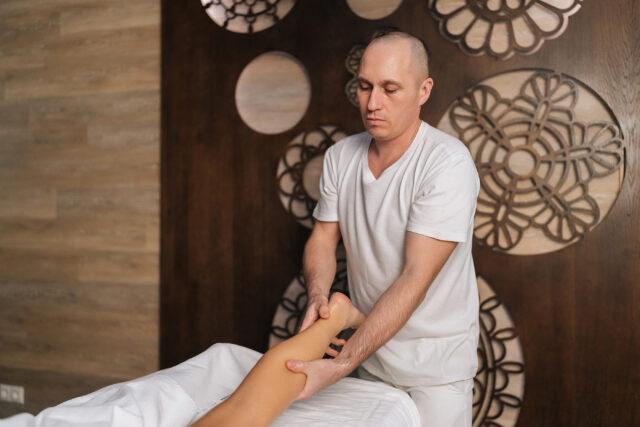 The journey of a massage therapist is one filled with purpose, fulfillment, and the opportunity to make a meaningful difference in the lives of others. For many, it’s not just a job but a calling—an invitation to engage in healing, relaxation, and the overall betterment of people’s physical and mental well-being. But what makes a career in massage therapy so satisfying? What are the elements that contribute to the high levels of job satisfaction that many massage therapists report? In this post, we’ll explore the various facets of this rewarding profession and why so many find it to be a deeply fulfilling career choice.
The journey of a massage therapist is one filled with purpose, fulfillment, and the opportunity to make a meaningful difference in the lives of others. For many, it’s not just a job but a calling—an invitation to engage in healing, relaxation, and the overall betterment of people’s physical and mental well-being. But what makes a career in massage therapy so satisfying? What are the elements that contribute to the high levels of job satisfaction that many massage therapists report? In this post, we’ll explore the various facets of this rewarding profession and why so many find it to be a deeply fulfilling career choice.
1. A Profession Rooted in Helping Others
At the core of massage therapy is the ability to help people. Whether it’s alleviating chronic pain, reducing stress, improving flexibility, or enhancing overall wellness, massage therapists are on the front lines of personal care. They get to witness the immediate and positive effects of their work, which can be incredibly rewarding. This sense of purpose—knowing that your work directly contributes to someone else’s well-being—can be a powerful driver of career satisfaction.
Massage therapists often speak of the profound impact they have on their clients’ lives. Many clients seek massage therapy as a holistic approach to managing chronic conditions, such as back pain, arthritis, or stress-related ailments. The relief they experience after a session can be transformative, both physically and emotionally. For the therapist, this transformation is not just a professional success but a personal fulfillment. Seeing a client leave the session feeling better, moving more freely, or simply wearing a relaxed smile is a daily affirmation of the therapist’s chosen path.
2. A Flexible and Personalized Career Path
One of the major appeals of massage therapy is the flexibility it offers. Massage therapists have the option to work in a variety of settings—from spas, wellness centers, and chiropractic offices to private practice and even mobile massage services. This flexibility extends to work schedules as well. Whether you prefer to work part-time, full-time, or just a few hours a week, you can often tailor your career to fit your lifestyle. For those who value work-life balance, this flexibility is a significant factor in job satisfaction.
Flexibility is particularly important for those who might be balancing multiple responsibilities, such as family, education, or other career interests. The ability to adjust work hours to accommodate personal needs is a key factor in reducing burnout and maintaining long-term satisfaction in the profession. Moreover, this flexibility allows therapists to explore different work environments and client demographics, giving them the freedom to find the niche that best suits their interests and skills.
Additionally, the rise of digital platforms and mobile applications has opened new avenues for massage therapists to offer their services. Mobile massage services, where therapists travel to clients’ homes or workplaces, have become increasingly popular. This not only provides convenience for clients but also allows therapists to expand their client base and work in diverse settings. The ability to create a personalized career path that aligns with individual goals and preferences is a significant advantage of this profession.
3. Opportunities for Specialization and Growth
Massage therapy is a field rich with opportunities for specialization. Therapists can choose to focus on specific modalities such as deep tissue massage, sports massage, prenatal massage, or reflexology. These specializations not only allow therapists to deepen their expertise but also to cater to specific client needs, which can be both financially rewarding and professionally fulfilling.
The pursuit of specialization often leads to a deeper sense of mastery and accomplishment. As therapists gain expertise in a particular modality, they often find themselves sought after by clients who need specialized care. For example, sports massage therapists may work with athletes to prevent injuries and enhance performance, while prenatal massage therapists support pregnant clients through the physical changes of pregnancy. This ability to make a significant difference in specific client populations adds a layer of fulfillment that goes beyond general practice.
Furthermore, the continuous learning aspect of massage therapy contributes to career satisfaction. Many therapists find joy in advancing their skills and knowledge through ongoing education and certification in new techniques. This commitment to growth keeps the career dynamic and interesting, preventing burnout and fostering a sense of accomplishment. Professional organizations like the American Massage Therapy Association (AMTA) and the National Certification Board for Therapeutic Massage & Bodywork (NCBTMB) offer resources for continuing education, helping therapists stay at the forefront of the field.
4. A Positive Work Environment
Unlike many other professions, massage therapy typically takes place in calm, serene environments designed to promote relaxation and healing. The ambiance of a massage therapy room—soft lighting, soothing music, and a general sense of peace—can make for a pleasant work environment. For those who value a tranquil and stress-free workplace, this is an enormous benefit that enhances overall job satisfaction.
The importance of a positive work environment cannot be overstated, especially in a profession where the therapist’s own well-being directly impacts the quality of care provided. A well-designed massage space not only helps clients relax but also contributes to the therapist’s sense of calm and focus. Many therapists find that the peaceful environment of their workspaces helps them maintain a balanced and centered state of mind, which is essential for providing effective therapy.
Moreover, the work environment in massage therapy often fosters a sense of community and connection among colleagues. Whether working in a spa, wellness center, or clinic, therapists often develop strong bonds with their coworkers, sharing knowledge and experiences that enrich their practice. This sense of camaraderie can significantly enhance job satisfaction, making the workplace a source of support and inspiration.
5. Building Strong Client Relationships
Massage therapy is inherently personal. Therapists often develop strong, trusting relationships with their clients. Over time, these relationships can become a source of joy and fulfillment as therapists witness their clients’ progress and improvements in health and well-being. The gratitude and appreciation expressed by clients can be a powerful motivator, reinforcing the therapist’s sense of purpose and satisfaction in their work.
The client-therapist relationship is built on trust, communication, and mutual respect. As therapists work with clients over time, they often become attuned to their clients’ physical and emotional needs, allowing for more personalized and effective care. This deep understanding not only enhances the therapeutic experience for the client but also enriches the therapist’s sense of connection and purpose.
In many cases, these relationships extend beyond the therapy room. Clients often express their gratitude through positive feedback, referrals, and even long-term loyalty. This ongoing relationship provides therapists with a steady stream of clients, contributing to both financial stability and professional fulfillment. The emotional rewards of knowing that your work has a lasting impact on someone’s life are immense and are often cited by therapists as one of the most satisfying aspects of their career.
6. Physical and Emotional Well-Being
It’s not just the clients who benefit from massage therapy—therapists themselves often experience physical and emotional rewards. The nature of the work requires therapists to maintain good physical health, including strength and flexibility. Additionally, the meditative and rhythmic nature of giving a massage can be a calming experience, helping therapists manage their own stress and maintain emotional balance.
Massage therapy is a physically demanding profession, but one that promotes health and wellness. Many therapists find that the physical nature of the job keeps them active and mindful of their own well-being. Regular exercise, proper body mechanics, and self-care practices are essential for sustaining a long and healthy career in massage therapy. This focus on health not only benefits the therapist but also enhances the quality of care provided to clients.
Emotionally, massage therapy can be a deeply rewarding practice. The repetitive, rhythmic movements of massage often create a meditative state for the therapist, allowing them to remain present and focused. This meditative quality can be soothing, helping therapists maintain emotional equilibrium even in the face of life’s stresses. The act of giving a massage can also be a form of emotional release, as therapists channel positive energy into their work, which can be both healing and rejuvenating for themselves.
7. Financial Independence and Career Stability
Massage therapy can offer a level of financial independence and career stability that is appealing to many. With the right business strategies and client base, therapists can build a lucrative practice. Moreover, the demand for skilled massage therapists is steady, contributing to job security. Whether working independently or within an established business, the financial aspect of massage therapy can be a significant contributor to career satisfaction.
The financial potential of a massage therapy career is often influenced by several factors, including location, specialization, and experience. Therapists who establish a strong client base, particularly in areas with high demand for wellness services, can achieve significant financial success. Additionally, those who specialize in high-demand modalities, such as sports massage or medical massage, may command higher rates, further enhancing their earning potential.
Beyond individual practice, massage therapists may also find opportunities in management, education, or product development within the wellness industry. These avenues provide additional career stability and the potential for financial growth. The ability to achieve financial independence while doing work that is personally fulfilling is a powerful motivator for many therapists.
8. The Joy of Continuous Learning and Adaptation
The world of health and wellness is always evolving, and massage therapists who are passionate about their work tend to embrace this evolution. Whether it’s learning new techniques, staying updated on the latest research, or exploring complementary fields like aromatherapy or yoga, the ability to continuously learn and adapt is both a challenge and a source of satisfaction for many therapists.
Continuous learning is a hallmark of the massage therapy profession. As new research emerges and techniques evolve, therapists are encouraged to expand their knowledge and skills. This commitment to lifelong learning not only keeps the practice fresh and engaging but also enhances the quality of care provided to clients. Many therapists find joy in mastering new techniques and integrating them into their practice, offering clients a broader range of services.
Furthermore, the integration of complementary practices, such as aromatherapy, energy work, or yoga, can enrich the therapeutic experience for both therapist and client. By expanding their skill set, therapists can offer a more holistic approach to wellness, addressing the physical, emotional, and spiritual needs of their clients. This holistic perspective is deeply satisfying for many therapists, who see their role as facilitators of overall well-being rather than just physical health.
9. Contribution to a Growing Wellness Movement
In today’s world, there’s a growing awareness of the importance of self-care and holistic wellness. Massage therapists are at the forefront of this movement, providing services that are increasingly recognized as essential to maintaining physical and mental health. Being part of a larger wellness community and contributing to a societal shift towards better health practices can provide a deep sense of pride and satisfaction.
The global wellness movement has brought increased recognition to the role of massage therapy in promoting health and well-being. As more people seek alternatives to conventional medicine, the demand for holistic therapies, including massage, has grown significantly. Massage therapists are now seen as vital contributors to preventive health care, offering services that not only address physical pain but also enhance mental and emotional resilience.
Being part of this broader wellness community can be incredibly fulfilling for massage therapists. The ability to contribute to a societal shift towards healthier living, and to educate clients about the benefits of regular massage, adds a layer of purpose to the profession. Many therapists take pride in being advocates for wellness, knowing that their work is part of a larger movement towards holistic health.
10. Personal Fulfillment and Lifestyle Compatibility
Ultimately, many massage therapists find that their career aligns with their personal values and lifestyle. Whether it’s the desire to help others, the appreciation for holistic health practices, or the need for a career that allows for creativity and personal expression, massage therapy offers a unique blend of professional and personal fulfillment. For those who choose this path, the rewards are often much greater than just a paycheck—they are about living a life in harmony with one’s values and passions.
For many therapists, massage therapy is more than just a job; it’s a way of life. The principles of holistic health, mindfulness, and compassion that guide their work often extend into their personal lives. This alignment between personal values and professional practice is a key factor in the high levels of job satisfaction reported by many therapists. The ability to live a life that is in harmony with one’s beliefs and passions is a rare and valuable gift, and massage therapy offers that opportunity.
Moreover, the creative aspects of massage therapy—such as designing personalized treatment plans or integrating different modalities—allow therapists to express their individuality within their practice. This creative freedom, combined with the ability to make a tangible difference in people’s lives, makes massage therapy a deeply fulfilling career for those who are passionate about health and wellness.
Conclusion: A Fulfilling Path Awaits
For those considering a career in massage therapy, the potential for job satisfaction is immense. From the opportunity to help others to the flexibility and personal growth the career offers, there are numerous reasons why massage therapists find their work fulfilling. It’s a career that not only provides financial stability but also nourishes the soul, offering a unique blend of professional success and personal fulfillment.
Whether you are drawn to the healing aspect, the positive work environment, or the continuous opportunities for learning, massage therapy is a career that offers a deep sense of purpose and satisfaction. If you’re looking for a profession that is as rewarding as it is impactful, massage therapy might just be the perfect fit for you.
—————————————————————————————————————-
Sources:
- American Massage Therapy Association (AMTA). “2023 Massage Profession Research Report.”
- Bureau of Labor Statistics (BLS). “Occupational Outlook Handbook – Massage Therapists.”
- Journal of Bodywork and Movement Therapies. (2019). “Specialization in Massage Therapy.”
- Massage Magazine. “The Role of Work Environment in Massage Therapy Job Satisfaction.”
- International Journal of Therapeutic Massage and Bodywork. (2018). “The Client-Therapist Relationship and Job Satisfaction.”
- Complementary Therapies in Clinical Practice. (2017). “The Meditative Effects of Massage Therapy.”
- Journal of Continuing Education in the Health Professions. (2021). “The Importance of Ongoing Education for Healthcare Professionals.”
- Global Wellness Institute. (2023). “The Wellness Economy: The Role of Massage Therapy.”
- Holistic Nursing Practice. (2020). “Personal Values and Career Satisfaction in Massage Therapy.”

Massage Therapy: Top 10 Study Skills for Success
 Introduction: Embarking on a journey into the world of massage therapy is an exciting and fulfilling endeavor. As a massage therapy student, you are about to dive into a field that combines science, art, and healing. To make the most of your educational experience and lay a solid foundation for a successful career, it is crucial to develop effective study skills. In this blog post, we will explore the top 10 study skills that will help you excel as a massage therapy student.
Introduction: Embarking on a journey into the world of massage therapy is an exciting and fulfilling endeavor. As a massage therapy student, you are about to dive into a field that combines science, art, and healing. To make the most of your educational experience and lay a solid foundation for a successful career, it is crucial to develop effective study skills. In this blog post, we will explore the top 10 study skills that will help you excel as a massage therapy student.
- Establish a Structured Study Routine: Creating a structured study routine is essential to maintain consistency and manage your time effectively. Designate specific study hours each day, eliminate distractions, and create a conducive environment for focused learning. This routine will foster discipline and optimize your ability to retain information.
- Set Clear Goals: Clearly define your goals and objectives for each study session. Establishing specific targets, such as mastering a particular technique or memorizing the skeletal system, will give you direction and purpose. Breaking down larger goals into smaller, manageable tasks will make your learning process more manageable and motivating.
- Utilize Active Learning Techniques: Engage actively with the material to enhance comprehension and retention. Instead of passively reading textbooks, employ active learning techniques such as summarizing information in your own words, teaching concepts to others, participating in group discussions, or creating flashcards for key terms and concepts. These activities encourage deeper understanding and better memory recall.
- Develop Note-Taking Skills: Effective note-taking is a fundamental study skill that helps consolidate information and provides a valuable resource for later review. Develop a system that works best for you, whether it’s using handwritten notes, digital apps, or a combination of both. Organize your notes, highlight essential points, and use visual aids like diagrams and mind maps to enhance understanding.
- Practice Hands-On Techniques: As a massage therapy student, hands-on practice is integral to mastering the craft. Regularly allocate time to practice various massage techniques, bodywork modalities, and palpation skills. Seek opportunities to practice on willing friends or family members, and consider joining study groups or attending workshops to refine your skills further.
- Make Use of Visual Resources: Visual aids can be incredibly valuable in understanding complex anatomical structures and physiological processes. Seek out visual resources such as anatomical charts, videos, interactive apps, or 3D models to enhance your understanding. These resources provide a dynamic and engaging way to reinforce your knowledge and grasp challenging concepts.
- Seek Out Multiple Learning Sources: While your course material serves as the foundation, supplementing it with additional learning sources can broaden your understanding. Explore textbooks, scholarly articles, reputable online resources, and journals related to massage therapy. This multidimensional approach exposes you to diverse perspectives and keeps your learning experience engaging and enriched.
- Engage in Self-Assessment: Regular self-assessment helps you gauge your progress and identify areas that require further attention. Create quizzes or practice exams for yourself using your study materials, or utilize online resources designed for massage therapy students. Self-assessment enhances your confidence, highlights knowledge gaps, and guides your future study efforts.
- Take Breaks and Practice Self-Care: While diligent study is crucial, it’s equally important to take breaks and prioritize self-care. Long hours of studying can lead to mental fatigue and decreased retention. Incorporate short breaks during your study sessions, engage in physical activity, practice relaxation techniques, and ensure you get enough sleep. Taking care of your well-being will enhance your overall academic performance.
- Collaborate and Communicate: Learning is often more effective when done in collaboration with others. Engage in study groups or online forums where you can discuss concepts, exchange ideas, and learn from your peers. Communication with instructors, mentors, and experienced professionals can also provide valuable insights and guidance.
Conclusion: Mastering the study skills necessary for success as a massage therapy student is a journey in itself. By establishing a structured routine, setting clear goals, utilizing active learning techniques, and engaging in hands-on practice, you’ll be well on your way to becoming a skilled and knowledgeable massage therapist. Remember to take care of yourself, seek out diverse learning sources, and collaborate with others to enhance your understanding. With these top 10 study skills in your arsenal, you are poised to excel in your massage therapy education and embark on a fulfilling career that promotes wellness and healing.

Attend a Hybrid Massage Therapy Program!
 Massage therapy is a practice that involves the application of pressure, movement, and vibration to the soft tissues of the body. It has been used for thousands of years to relieve pain, promote relaxation, and improve overall health and well-being. Today, massage therapy is recognized as a valuable form of complementary medicine and is offered in a variety of settings, including spas, clinics, and hospitals.
Massage therapy is a practice that involves the application of pressure, movement, and vibration to the soft tissues of the body. It has been used for thousands of years to relieve pain, promote relaxation, and improve overall health and well-being. Today, massage therapy is recognized as a valuable form of complementary medicine and is offered in a variety of settings, including spas, clinics, and hospitals.
If you’re interested in pursuing a career in massage therapy, you may be considering attending a massage therapy program. However, with the advent of hybrid learning, you now have the option of attending a hybrid massage therapy program, which combines both online and in-person learning. In this blog post, we’ll explore the benefits of attending a hybrid massage therapy program in greater detail.
- Flexibility: One of the biggest benefits of a hybrid massage therapy program is flexibility. With a hybrid program, you have the flexibility to attend classes online or in-person. This means that you can tailor your learning experience to fit your schedule and preferences. For example, if you have a busy work schedule, you may choose to attend online classes during the week and in-person classes on the weekends. Alternatively, if you prefer to attend classes in-person, you can do so without having to commit to a full-time schedule.
- Convenience: Attending a hybrid massage therapy program also offers convenience. With online classes, you can learn from the comfort of your own home or any location that has an internet connection. This means that you can save time and money on commuting, parking, and other expenses associated with attending in-person classes. Online classes also allow you to learn at your own pace, which can be helpful if you need more time to absorb the material or have other commitments that take up your time.
- Personalization: Another benefit of a hybrid massage therapy program is personalization. With online classes, you can learn at your own pace and review materials as often as you need to. You can also communicate with your instructors and classmates through online forums and email, which can help you get personalized feedback and support. In-person classes also provide opportunities for personalized learning, as you can receive direct feedback from instructors and collaborate with other students in hands-on exercises.
- Hands-on experience: While online classes provide a great deal of flexibility and convenience, there is no substitute for hands-on experience. Attending in-person classes allows you to practice massage techniques on real clients under the supervision of experienced instructors. This gives you the opportunity to develop your skills and gain valuable experience in a real-world setting. In-person classes also provide opportunities to ask questions and receive feedback in real-time, which can be helpful for improving your technique and building your confidence.
- Cost-effective: A hybrid massage therapy program can provide significant cost savings for students. By attending online classes, students can save money on transportation costs, such as gas and parking fees, that are associated with commuting to and from school. Additionally, students can save money on other expenses, such as meals and childcare, that may be necessary when attending in-person classes. By attending online classes from the comfort of their own homes or other locations, students can avoid these additional costs and focus on their studies. Furthermore, hybrid programs often offer financial aid and scholarships that can help offset the cost of tuition. By taking advantage of these resources, students can make their massage therapy education more affordable and accessible. Overall, a hybrid massage therapy program provides a cost-effective way for students to pursue their career goals while saving money on the associated costs of attending school.
- Career readiness: Attending a hybrid massage therapy program can also help you prepare for a successful career in massage therapy. With a combination of online and in-person classes, you can develop a comprehensive understanding of massage techniques, anatomy, and physiology. You can also learn about business and marketing strategies that can help you build and grow your own massage therapy practice. In addition, attending a hybrid program can help you develop the soft skills that are essential for success in any career, such as communication, teamwork, and problem-solving.
- Networking opportunities: Finally, attending a hybrid massage therapy program provides opportunities for networking. In-person classes also provide opportunities to ask questions and receive feedback in real-time, which can be helpful for improving your technique and building your confidence. Additionally, attending in-person classes allows you to network with other students and instructors in the program. This can help you build connections in the massage therapy community and learn from experienced professionals.Attending a hybrid massage therapy program can also help you develop important soft skills that are essential for success in any career. Online classes require self-motivation, time management, and communication skills to succeed. These skills are highly valued by employers and can help you stand out in the job market. In-person classes provide opportunities for collaboration, teamwork, and leadership development, which are also highly valued by employers. By developing these skills in a hybrid program, you can become a well-rounded candidate for massage therapy jobs and other careers.
In conclusion, a hybrid massage therapy program offers a flexible, convenient, and personalized approach to learning that can help you achieve your career goals. By combining online and in-person classes, you can get the best of both worlds and develop a comprehensive understanding of massage techniques, anatomy, and physiology. You can also learn about business and marketing strategies that can help you build and grow your own massage therapy practice. With hands-on experience, cost savings, career readiness, networking opportunities, and the development of important soft skills, a hybrid massage therapy program can be an excellent investment in your future.

Being a Massage Therapist -10 Benefits
 Being a massage therapist can be an incredibly rewarding and fulfilling career. Not only do you get to help people feel better physically and emotionally, but you also have the opportunity to make a positive impact on their overall well-being. In this blog post, we’ll take a look at the top 10 best things about being a massage therapist.
Being a massage therapist can be an incredibly rewarding and fulfilling career. Not only do you get to help people feel better physically and emotionally, but you also have the opportunity to make a positive impact on their overall well-being. In this blog post, we’ll take a look at the top 10 best things about being a massage therapist.
- Helping people feel better
One of the most obvious benefits of being a massage therapist is the ability to help people feel better physically. Whether your clients are dealing with chronic pain, injury, or just need to relax, your massage techniques can provide relief and promote healing.
- Building relationships with clients
As a massage therapist, you have the opportunity to build long-lasting relationships with your clients. Many people see their massage therapist regularly, which means you have the chance to get to know them on a personal level and help them on their journey towards wellness.
- A flexible schedule
If you’re looking for a career with a flexible schedule, massage therapy is a great option. You can set your own hours and work as little or as much as you want. This can be especially helpful if you have other commitments, such as family or school.
- A variety of work settings
As a massage therapist, you can work in a variety of settings, from spas and resorts to hospitals and clinics. This can provide a lot of variety in your work and allow you to explore different aspects of the profession.
- Continuous learning and growth
There’s always something new to learn in the field of massage therapy. From new techniques and tools to advances in technology, there are plenty of opportunities for continuous learning and growth. This can help you stay engaged and excited about your work.
- A physically active job
If you’re someone who enjoys staying active, massage therapy can be a great career choice. You’ll be on your feet for most of the day and using your hands and arms to perform massage techniques, which can provide a good workout.
- A positive impact on mental health
Massage therapy isn’t just good for physical health; it can also have a positive impact on mental health. Massage has been shown to reduce stress, anxiety, and depression, and can promote relaxation and improve mood.
- A career that’s in demand
As more people become interested in natural and alternative forms of healthcare, the demand for massage therapists continues to grow. This means there are plenty of job opportunities available and a good outlook for the future of the profession.
- The ability to be self-employed
If you’re someone who values independence and autonomy, becoming a self-employed massage therapist may be a good fit. You can set your own rates and build your own business, which can be a fulfilling and rewarding experience.
- Making a difference in people’s lives
Perhaps the biggest benefit of being a massage therapist is the ability to make a positive difference in people’s lives. Whether you’re helping someone recover from an injury, manage chronic pain, or just relax and unwind, your work can have a profound impact on their well-being.
In conclusion, being a massage therapist can be a wonderful career choice for those who are passionate about helping others and promoting wellness. From the ability to make a positive impact on people’s lives to the flexibility and autonomy that comes with being a self-employed massage therapist, there are plenty of reasons to consider pursuing this rewarding profession.
For more information about being a massage therapist contact our massage school admissions team





